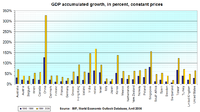
Photo from wikipedia
The paper estimates dynamic effects of pandemics on GDP per capita with local projections, controlling for the effects of wars and weather conditions, using a novel dataset that covers 33… Click to show full abstract
The paper estimates dynamic effects of pandemics on GDP per capita with local projections, controlling for the effects of wars and weather conditions, using a novel dataset that covers 33 countries and stretches back to the thirteenth century. On average, pandemics are found to have prolonged and highly statistically significant effects on GDP per capita—a pandemic killing 1% of the population tends to increase GDP per capita by approx. 0.3% after about 20 years. The study of a more detailed dataset available for the UK reveals that this results mainly from an increase in per capita land and a disproportionate impact of pandemics on low-productivity workers, while monetary expansion, institutional change and innovation could also play some role. At the same time, the effects of pandemics are found to vary with scale and across time and countries, with positive effects present following the Black Death and the Spanish flu pandemics, especially in Northern Europe. This suggests that only the largest and most unexpected pandemics have a positive impact on income.
Journal Title: Empirical Economics
Year Published: 2022
Link to full text (if available)
Share on Social Media: Sign Up to like & get
recommendations!